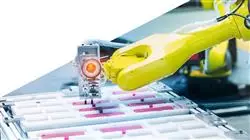University certificate
The world's largest artificial intelligence faculty”
Introduction to the Program
A 100% online program that provides you with the most effective Deep Learning techniques to solve real problems and develop innovative solutions"

Deep Learning has a wide diversity of fields such as Robotics, Computer Vision and Natural Language Processing. Currently, the implementation of these advanced techniques is being increasingly demanded in different fields of work. Among them, the Marketing sector stands out, since Deep Learning tools provide these companies with multiple benefits. For example, they serve to analyze large sets of customer data to identify more precise audience segments. In this way, companies are able to personalize their strategies and messages in order to meet the specific needs of each audience.
Given this reality, TECH creates a Postgraduate diploma that will provide experts with a comprehensive knowledge on Deep Learning Applications. The curriculum is designed to equip students with the most cutting-edge and effective tools for training Neural Networks. To this end, the curriculum will delve into both neurons and recurrent layer architecture. The program will also delve intoTransformers models for natural language processing, enabling graduates to achieve superior performance in a variety of tasks such as fluent text generation.
To achieve this update, TECH provides multiple pedagogical resources based on multimedia pills, case study simulations and specialized readings for students to enjoy dynamic learning. In addition, students will not have to invest many hours of study, since the Relearning method will help them to consolidate the most important concepts in a much simpler way. Therefore, professionals are faced with a quality academic option that is perfectly compatible with their daily responsibilities, as they can individually plan their schedules and evaluation chronograms. The only thing they will need to access the Virtual Campus is an electronic device with Internet access, and they can even use their cell phones.
You will master Hugging Face's Transformers tool for learning transfer. And in just 6 months with this Postgraduate diploma!"
This Postgraduate diploma in Deep Learning Applications contains the most complete and up-to-date program on the market. The most important features include:
- The development of case studies presented by experts in Deep Learning Applications
- The graphical, schematic and practical contents with which it is conceived gather technological and practical information on those disciplines that are essential for professional practice
- Practical exercises where the self-assessment process can be carried out to improve learning
- Its special emphasis on innovative methodologies
- Theoretical lessons, questions to the expert, debate forums on controversial topics, and individual reflection assignments
- Content that is accessible from any fixed or portable device with an Internet connection
You'll delve into sentiment analysis with Deep Learning algorithms to monitor social networks"
The program’s teaching staff includes professionals from the sector who contribute their work experience to this program, as well as renowned specialists from leading societies and prestigious universities.
The multimedia content, developed with the latest educational technology, will provide the professional with situated and contextual learning, i.e., a simulated environment that will provide immersive education programmed to learn in real situations.
This program is designed around Problem-Based Learning, whereby the professional must try to solve the different professional practice situations that arise during the academic year For this purpose, the students will be assisted by an innovative interactive video system created by renowned and experienced experts.
You will handle the construction of coding architectures and be able to automatically extract meaningful features from data"

TECH's revolutionary Relearning methodology will provide you with the flexibility to organize your study pace to suit your circumstances"
Syllabus
The Postgraduate diploma in Deep Learning Applications will focus on processing sequences using both Recurrent and Convolutional Neural Networks. Students will examine the architecture of the layers, taking into account their applications and backpropagation over time. In tune with this, they will delve into natural language processing to generate texts and translations in an automated way. Likewise, the didactic contents will also delve into diffusion models (including autoencoders and generative adversarial networks). In this way, graduates will produce realistic data samples and model probability distributions effectively.

You will raise your professional potential in the field of Computer Vision thanks to this 100% online Postgraduate diploma"
Module 1. Processing Sequences using RNN (Recurrent Neural Networks) and CNN (Convolutional Neural Networks)
1.1. Recurrent Neurons and Layers
1.1.1. Types of Recurring Neurons
1.1.2. Architecture of a Recurrent Layer
1.1.3. Applications of Recurrent Layers
1.2. Recurrent Neural Network (RNN) Training
1.2.1. Backpropagation over Time (BPTT)
1.2.2. Stochastic Downward Gradient
1.2.3. Regularization in RNN Training
1.3. Evaluation of RNN Models
1.3.1. Evaluation Metrics
1.3.2. Cross Validation
1.3.3. Hyperparameter Tuning
1.4. Prerenal RNNs
1.4.1. Pre-trained Networks
1.4.2. Transfer of Learning
1.4.3. Fine Tuning
1.5. Forecasting a Time Series
1.5.1. Statistical Models for Forecasting
1.5.2. Time Series Models
1.5.3. Models based on Neural Networks
1.6. Interpretation of Time Series Analysis Results
1.6.1. Main Component Analysis
1.6.2. Cluster Analysis
1.6.3. Correlation Analysis
1.7. Handling of Long Sequences
1.7.1. Long Short-Term Memory (LSTM)
1.7.2. Gated Recurrent Units (GRU)
1.7.3. 1D Convolutionals
1.8. Partial Sequence Learning
1.8.1. Deep Learning Methods
1.8.2. Generative Models
1.8.3. Reinforcement Learning
1.9. Practical Application of RNN and CNN
1.9.1. Natural Language Processing
1.9.2. Pattern Recognition
1.9.3. Computer Vision
1.10. Differences in Classical Results
1.10.1. Classical vs. RNN Methods
1.10.2. Classical vs. CNN Methods
1.10.3. Difference in Training Time
Module 2. Natural Language Processing (NLP) with Natural Recurrent Networks (NRN) and Attention
2.1. Text Generation Using RNN
2.1.1. Training an RNN for Text Generation
2.1.2. Natural Language Generation with RNN
2.1.3. Text Generation Applications with RNN
2.2. Training Data Set Creation
2.2.1. Preparation of the Data for Training an RNN
2.2.2. Storage of the Training Dataset
2.2.3. Data Cleaning and Transformation
2.3. Sentiment Analysis
2.3.1. Classification of Opinions with RNN
2.3.2. Detection of Themes in Comments
2.3.3. Sentiment Analysis with Deep Learning Algorithms
2.4. Encoder-decoder Network for Neural Machine Translation
2.4.1. Training an RNN for Machine Translation
2.4.2. Use of an Encoder-decoder Network for Machine Translation
2.4.3. Improving the Accuracy of Machine Translation with RNNs
2.5. Attention Mechanisms
2.5.1. Application of Care Mechanisms in RNN
2.5.2. Use of Care Mechanisms to Improve the Accuracy of the Models
2.5.3. Advantages of Attention Mechanisms in Neural Networks
2.6. Transformer Models
2.6.1. Using TransformerModels for Natural Language Processing
2.6.2. Application of Transformer Models for Vision
2.6.3. Advantages of Transformer Models
2.7. Transformers for Vision
2.7.1. Use of Transformer Models for Vision
2.7.2. Image Data Preprocessing
2.7.3. Training of a Transformer model for vision
2.8. Hugging Face’s TransformersLibrary
2.8.1. Using the Hugging Face’s TransformersLibrary
2.8.2. Hugging Face’s TransformersLibrary App
2.8.3. Advantages of Hugging Face’s Transformers Library
2.9. Other Transformers Libraries. Comparison
2.9.1. Comparison between different TransformersLibraries
2.9.2. Use of the other Transformers Libraries
2.9.3. Advantages of the other Transformers Libraries
2.10. Development of an NLP Application with RNN and Attention. Practical Application
2.10.1. Development of a Natural Language Processing Application with RNN and Attention
2.10.2. Use of RNN, Attention Mechanisms and Transformers Models in the Application
2.10.3. Evaluation of the Practical Application
Module 3. Autoencoders, GANs, and Diffusion Models
3.1. Representation of Efficient Data
3.1.1. Dimensionality Reduction
3.1.2. Deep Learning
3.1.3. Compact Representations
3.2. PCA Realization with an Incomplete Linear Automatic Encoder
3.2.1. Training Process
3.2.2. Implementation in Python
3.2.3. Use of Test Data
3.3. Stacked Automatic Encoders
3.3.1. Deep Neural Networks
3.3.2. Construction of Coding Architectures
3.3.3. Use of Regularization
3.4. Convolutional Autoencoders
3.4.1. Design of Convolutional Models
3.4.2. Convolutional Model Training
3.4.3. Results Evaluation
3.5. Automatic Encoder Denoising
3.5.1. Application of Filters
3.5.2. Design of Coding Models
3.5.3. Use of Regularization Techniques
3.6. Sparse Automatic Encoders
3.6.1. Increasing Coding Efficiency
3.6.2. Minimizing the Number of Parameters
3.6.3. Using Regularization Techniques
3.7. Variational Automatic Encoders
3.7.1. Use of Variational Optimization
3.7.2. Unsupervised Deep Learning
3.7.3. Deep Latent Representations
3.8. Generation of Fashion MNIST Images
3.8.1. Pattern Recognition
3.8.2. Image Generation
3.8.3. Deep Neural Networks Training
3.9. Generative Adversarial Networks and Diffusion Models
3.9.1. Content Generation from Images
3.9.2. Modeling of Data Distributions
3.9.3. Use of Adversarial Networks
3.10. Implementation of the Models. Practical Application
3.10.1. Implementation of the Models
3.10.2. Use of Real Data
3.10.3. Results Evaluation

This will provide key education to advance in your career. Enroll now and notice immediate career advancement"
Postgraduate Diploma in Deep Learning Applications
Immerse yourself in the exciting world of Deep Learning applications and achieve mastery in this cutting-edge technology with an innovative Postgraduate Diploma created by TECH Global University. Designed for professionals eager to explore the limits of artificial intelligence, this program will equip you with the skills and knowledge necessary to excel in the development and application of Deep Learning models in various fields. Through an innovative syllabus, delivered in an online modality, you will learn the fundamentals of Deep Learning, including neural networks, deep learning algorithms, and advanced architectures such as convolutional neural networks (CNNs) and recurrent neural networks (RNNs). These foundations will prepare you to understand and create complex models in the rest of the program. In addition, you will learn how to use popular frameworks such as TensorFlow and PyTorch to build scalable and efficient applications that take full advantage of the power of Deep Learning.
Get qualified with a Postgraduate Diploma in Deep Learning Applications
Here, we make use of a virtual methodology and an innovative interactive system that will make your learning experience the most enriching one. With our syllabus, you will discover a wide range of Deep Learning applications in fields such as computer vision, natural language processing, medicine, robotics and more. Through a theoretical-practical approach, you will learn how these applications are transforming entire industries and creating new opportunities for innovation. As you progress through the program, you will develop advanced Deep Learning models to address specific problems in different domains. You will learn to design, train and evaluate deep neural networks that are capable of performing sophisticated tasks such as image classification, text generation and time series prediction. In this way, you will envision your future as a highly skilled and in-demand Deep Learning application expert. You will become a leader in the creation and application of artificial intelligence solutions that drive innovation and progress in various industries and sectors. Enroll now and begin your journey towards mastery in Deep Learning!







